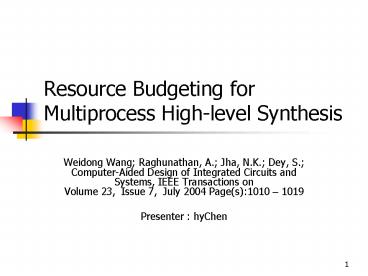Resource Budgeting for Multiprocess Highlevel Synthesis - PowerPoint PPT Presentation
1 / 20
Title:
Resource Budgeting for Multiprocess Highlevel Synthesis
Description:
Computer-Aided Design of Integrated Circuits and Systems, IEEE Transactions on ... Logic synthesis to physical Synopsys Design Comiper. NEC's .35 cell-based ... – PowerPoint PPT presentation
Number of Views:31
Avg rating:3.0/5.0
Title: Resource Budgeting for Multiprocess Highlevel Synthesis
1
Resource Budgeting for Multiprocess High-level
Synthesis
- Weidong Wang Raghunathan, A. Jha, N.K. Dey,
S.Computer-Aided Design of Integrated Circuits
and Systems, IEEE Transactions onVolume 23,
Issue 7, July 2004 Page(s)1010 1019 - Presenter hyChen
2
Outline
- Abstract
- Introduction
- Relate Work
- Methodology
- Experimental Result
- Conclusion
3
Abstract
- AbstractThis paper presents a new high-level
synthesis methodology to generate optimized
register-transfer level (RTL implementations for
multiprocess behavioral descriptions. The
concurrent communicating processes specification
paradigm is widely used in digital circuit and
system design, and is employed in all popular
hardware description languages. It has been shown
that interprocess communication and
synchronization can result in complex timing
interdependencies, which significantly affect the
performance of a multiprocess system. - In this paper, we demonstrate that
state-of-the-art high-level synthesis tools can
generate significantly suboptimal implementations
for behaviors that contain concurrent
communicating processes. We present an analysis
of how interprocess communication impacts
high-level synthesis steps, and describe a new
methodology to adapt existing high-level
synthesis tools to optimize multiprocess
descriptions. Our methodology is based on
executing multiprocess performance analysis and
process-by-process scheduling in an iterative
manner. We present algorithms for key steps in
the proposed methodology.
4
Abstract-cont.
- We have performed extensive experiments in the
context of a commercial high-level design flow to
evaluate the proposed techniques. The results
clearly demonstrate the utility of our techniques
in synthesizing implementations with superior
area, performance, and energy consumption. For
example, up to 40.0 performance improvement
(average of 35.6) was achieved with little or no
area overhead (average of 4.8). In effect, the
proposed techniques lead to a shift of the entire
area-delay tradeoff curve for a design, to
include superior designs that were hitherto
infeasible. Our techniques also simultaneously
result in up to 50.0 (average of 33.5)
improvement in energy and up to 69.0 (average of
58.3) improvement in the energy-delay product.
5
Introduction
- High-Level synthesis is an extensively researched
field. - All research in high-level synthesis have focused
on synthesis of behavioral descriptions that
contain a single process. - Whats the problem?
- A multiprocess system is handled by synthesizing
each process separately into an RTL
implementation.
6
Relate Work
- 1213
- Correct synchronization in multiprocess high
level synthesis. - 1415
- A process graph analyzer for multiprocess.
- 1617
- A worst case performance analysis for
multiprocess.
7
Example Control Flow Graph for Ethernet
8
Example Different Resource budgets
- Global resource adder(6), bit-operator(3),
comparator(7) - Equal vs. Operation Count vs. Papers method
9
Example-Method
- Budget the resources to each process
- Operations which appear in the critical path as
well as near-critical paths. - The critical path can change after resource
budgeting and rescheduling.
10
Methodology for High-level Synthesis
11
Methodology (cont.)
- Performance Analysis
- Using simulation-based.
- Criticality Calculation
- Operations which appear in the critical path as
well as near-critical paths. - e-critical path L(p)
- L(p) gt (1-e)L0, 0 ltelt 1
- State transition graph (STG)
- Generated from using the testbench to resolve the
execution of branches and loops.
12
Methodology-Pseudocode
Depth-first search
13
Methodology-STG
14
Methodology (cont.)
- Criticality Driven Resource Budgeting
- Rel_Res_Reqi,j (each process)
- 1 ?k1,OPk?i criticality (OPk)
- i process, j resource type
- Rel_Res_Reqj (total process)
- ?i1 Rel_Res_Reqi,j
- Ri,j (Resource Budgeting)
- Ri,j each process/ total process (Resj)
15
Methodology-Discussion
- Clock selection
- Different processes can use different clocks.
- Synchronizing signals vs. Data signals
- No discussion about Data signals.
16
Experimental-Benchmarks
- Behavior to High-level synthesis Cyber
- Logic synthesis to physical Synopsys Design
Comiper - NECs .35 cell-based array library
17
Experimental Results - Area and Performance
18
Experimental Results Energy
Average reduce 33.5
58.3
19
Experimental-tradeoff curve
- Original the better result chosen from equal
distribution and operation count based
distribution
20
Conclusion
- Concurrent communicating processes are widely
used as a behavioral hardware specification
paradigm. - Developed a methodology to optimize multiprocess
designs during high-level synthesis.































